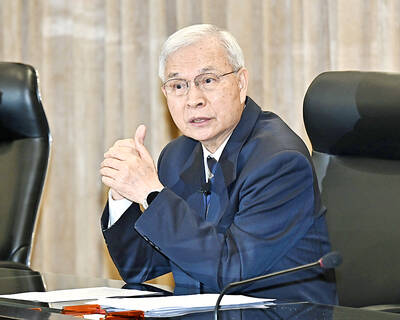Japan's transport minister, Chikage Ogi, is visiting China this week to lobby the government to choose trains built by Japanese companies for a US$16 billion high-speed rail link between Beijing and Shanghai.
Ogi, who arrived in Beijing yesterday, is also meeting officials to promote tourism to Japan. News reports have said China favors Japanese technology for the 1,287km line to shorten travel times between the country's capital and its financial center from 13 hours to less than 5.
Her visit comes after French Trade Minister Francois Loos visited the country in July and lobbied for Alstom SA's Train a Grande Vitesse.
Both Japan's Shinkansen and Alstom's TGV are slower than a train developed by Siemens AG and ThyssenKrupp AG used to link Shanghai and its main international airport, an option the government considers too expensive for the new line.
"The race hasn't finished in favor of the Japanese," Loos said in Beijing, after meeting China's planning and railway ministers on July 25 to lobby for the project.
Mitsubishi Heavy Industries Ltd, Japan's biggest heavy machinery maker, and Kawasaki Heavy Industries Ltd, the country's second biggest, are among suppliers of the 168-mile-per-hour Shinkansen trains, and are part of a group that has said it plans to bid for the project.
Alstom's TGV, which it builds and runs, can travel at 186 miles per hour.
Itochu Corp, Hitachi Ltd, Mitsubishi Corp, Mitsubishi Electric Corp and Nippon Steel Corp are among members of the Japanese group formed in 1995 to bid for the link. Officials declined to comment on the project.
East Japan Railway Co, Japan's biggest railway company, West Japan Railway Co, and Central Japan Railway Co, which operate the trains, are also promoting the technology.
The project is one of a number of large infrastructure works planned to ensure China's economic growth doesn't get stymied by the lack of roads, rails and services.
The world's biggest dam, the Three Gorges Dam, built to control flooding on the Yangzte River and produce power, started filling up in July.
The Chinese government will run a record 320 billion yuan (US$39 billion) budget deficit this year because of increased public works spending.
Among works underway are 176,000 kilometers of new roads around the country and a US$3.3 billion railway from western China's Qinghai province to Tibet.
The Chinese government hasn't said when it will announce the winning bid for the Beijing to Shanghai link.
Officials from the State Development Planning Commission, which is responsible for the project, declined to comment.
A decision on the contracted may be made by November, the Nikkei Weekly newspaper reported today without citing the source of its information.
Ogi is scheduled to meet Chinese Premier Wen Jiabao, Beijing Mayor Wang Qishan, and deputy ministers of the railway and state planning commissions, according to an itinerary provided by the Japanese Embassy in China.
The proposed Beijing-Shang-hai railway will traverse China's two longest waterways, the Yellow River and the Yangtze River, and cut across some of the country's most densely populated provinces.
China already has the world's fastest train, the US$1.25 billion magnetic levitation train built by Siemens and ThyssenKrupp, that started trial runs in May.
The train can travel the 19 miles between Shanghai's Pudong airport and the city's financial center in eight minutes, at a speed of up to 267 miles an hour.
A longer version of the train, called the maglev, will be used to link Shanghai with eastern China's Hangzhou city, cutting the travel time on the 236-mile route to 30 minutes from three hours.
Maglev technology is unlikely to be used to build the Beijing- Shanghai link, because its cost would make it uneconomical, Wu Xiangming, general manager of Shanghai Maglev Transportation Development Co, said.
"From an engineering standpoint, it is feasible to use magnetic-levitation technology to cover the 1,300km from Beijing to Shanghai, but it would come at a huge cost," Wu said.
The is a "50-50 chance" Japan-ese companies will win the contract, Ogi said on July 8, according to an AFP report.

The CIA has a message for Chinese government officials worried about their place in Chinese President Xi Jinping’s (習近平) government: Come work with us. The agency released two Mandarin-language videos on social media on Thursday inviting disgruntled officials to contact the CIA. The recruitment videos posted on YouTube and X racked up more than 5 million views combined in their first day. The outreach comes as CIA Director John Ratcliffe has vowed to boost the agency’s use of intelligence from human sources and its focus on China, which has recently targeted US officials with its own espionage operations. The videos are “aimed at

STEADFAST FRIEND: The bills encourage increased Taiwan-US engagement and address China’s distortion of UN Resolution 2758 to isolate Taiwan internationally The Presidential Office yesterday thanked the US House of Representatives for unanimously passing two Taiwan-related bills highlighting its solid support for Taiwan’s democracy and global participation, and for deepening bilateral relations. One of the bills, the Taiwan Assurance Implementation Act, requires the US Department of State to periodically review its guidelines for engagement with Taiwan, and report to the US Congress on the guidelines and plans to lift self-imposed limitations on US-Taiwan engagement. The other bill is the Taiwan International Solidarity Act, which clarifies that UN Resolution 2758 does not address the issue of the representation of Taiwan or its people in

US Indo-Pacific Commander Admiral Samuel Paparo on Friday expressed concern over the rate at which China is diversifying its military exercises, the Financial Times (FT) reported on Saturday. “The rates of change on the depth and breadth of their exercises is the one non-linear effect that I’ve seen in the last year that wakes me up at night or keeps me up at night,” Paparo was quoted by FT as saying while attending the annual Sedona Forum at the McCain Institute in Arizona. Paparo also expressed concern over the speed with which China was expanding its military. While the US

SHIFT: Taiwan’s better-than-expected first-quarter GDP and signs of weakness in the US have driven global capital back to emerging markets, the central bank head said The central bank yesterday blamed market speculation for the steep rise in the local currency, and urged exporters and financial institutions to stay calm and stop panic sell-offs to avoid hurting their own profitability. The nation’s top monetary policymaker said that it would step in, if necessary, to maintain order and stability in the foreign exchange market. The remarks came as the NT dollar yesterday closed up NT$0.919 to NT$30.145 against the US dollar in Taipei trading, after rising as high as NT$29.59 in intraday trading. The local currency has surged 5.85 percent against the greenback over the past two sessions, central